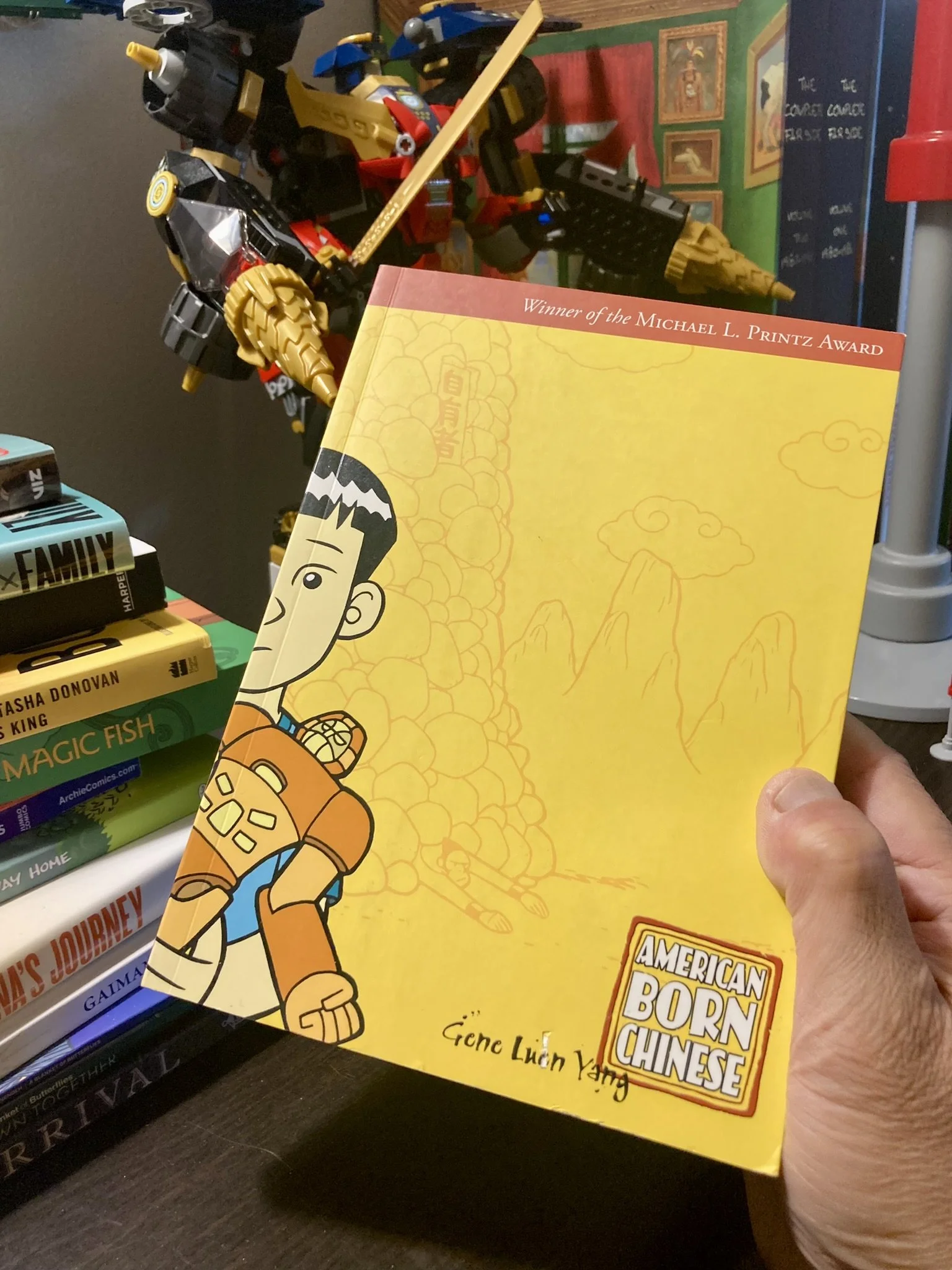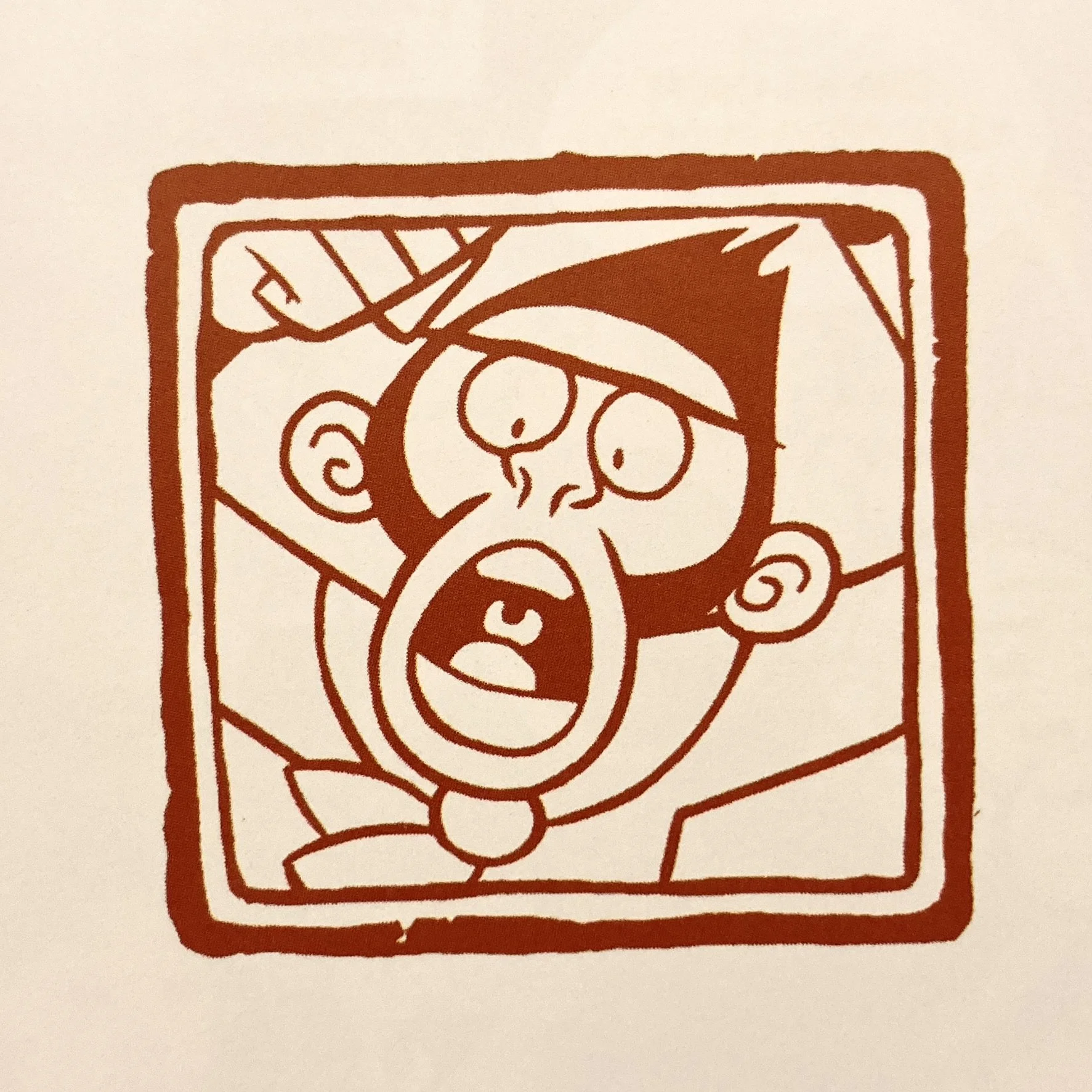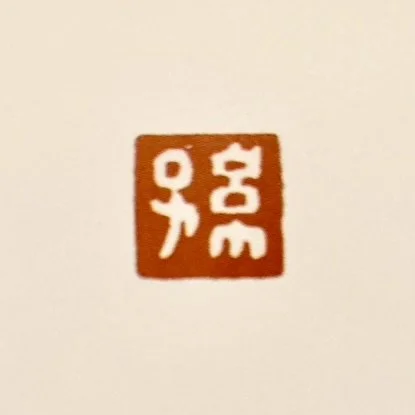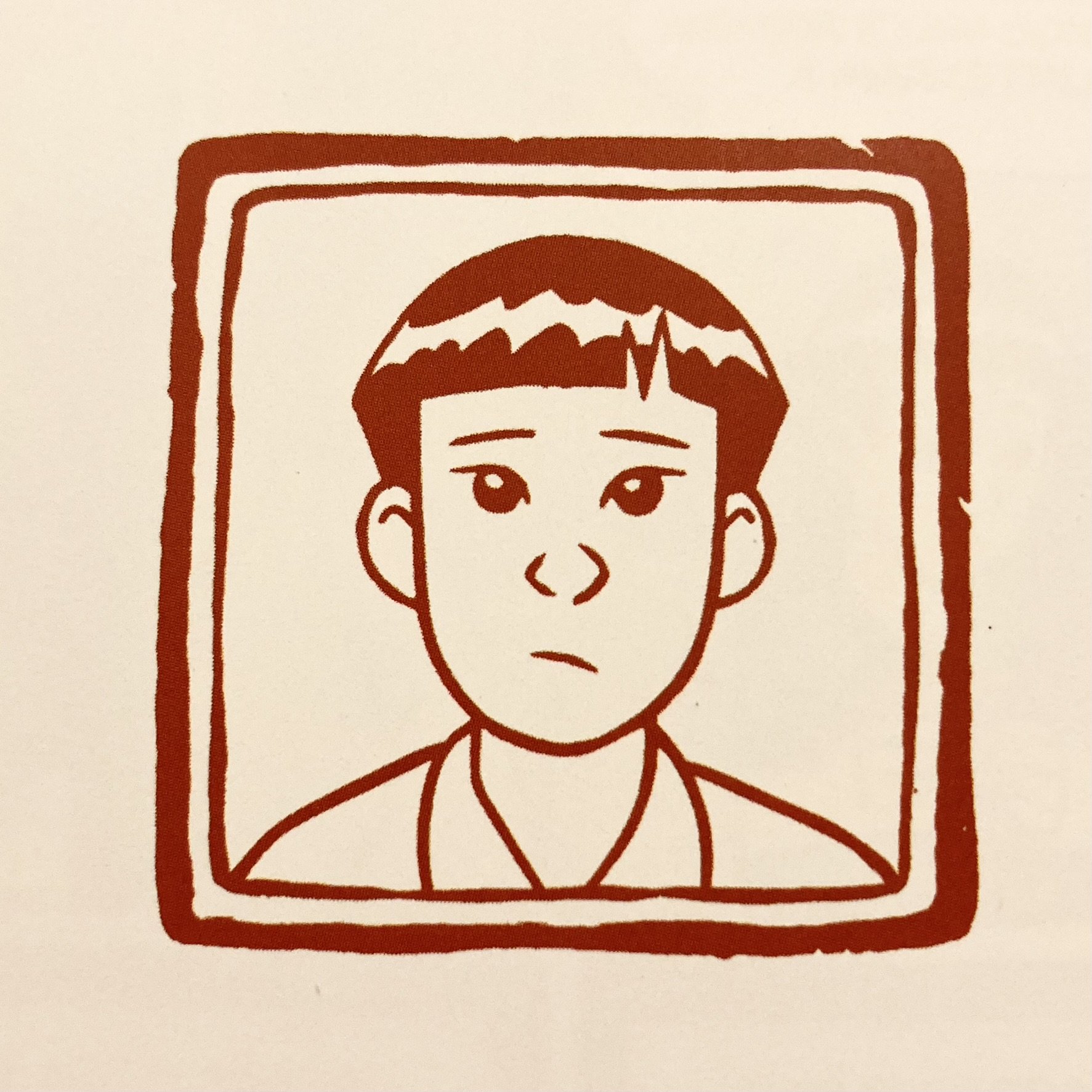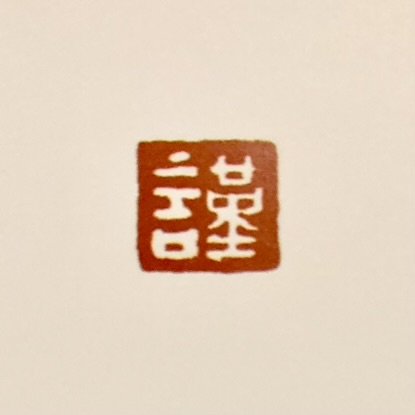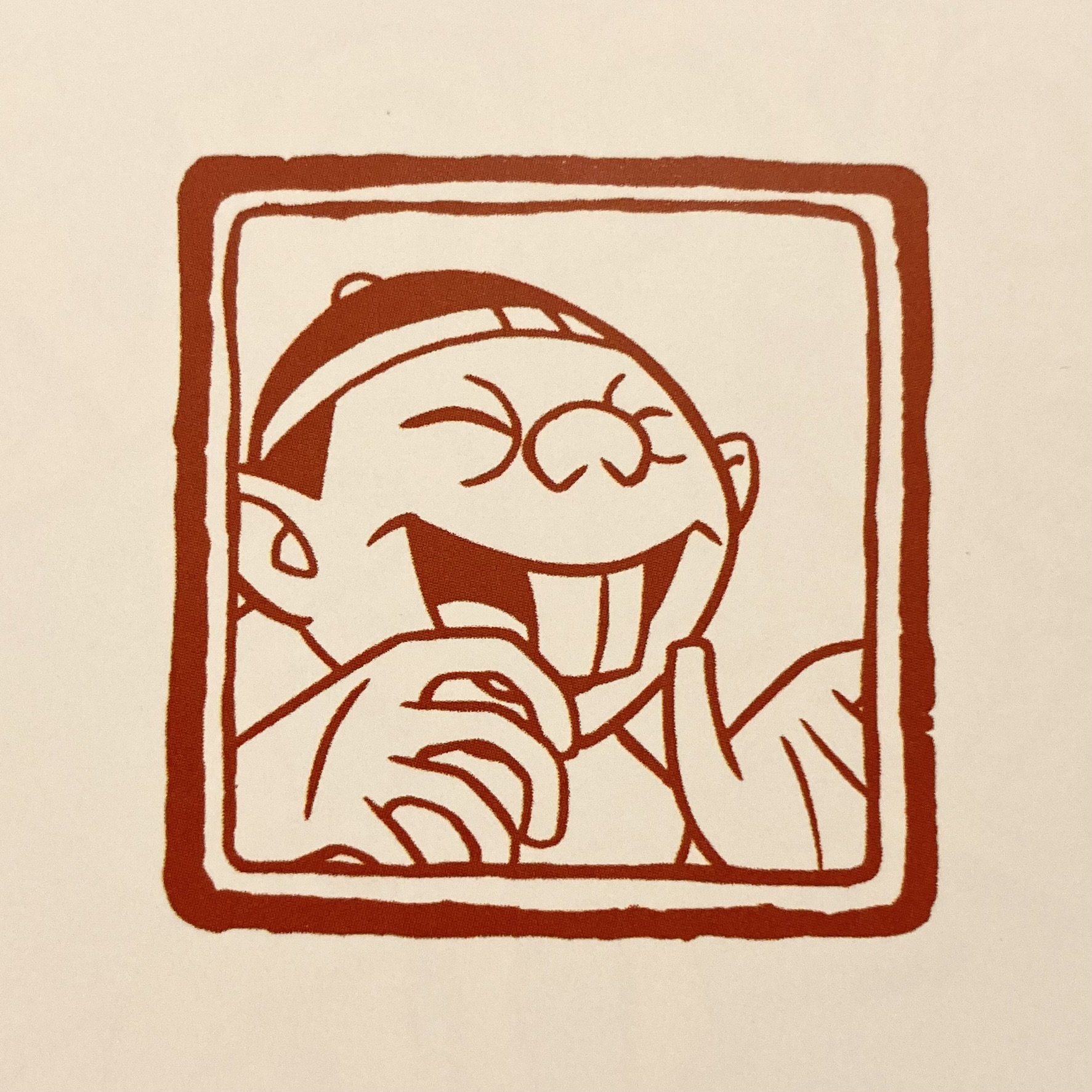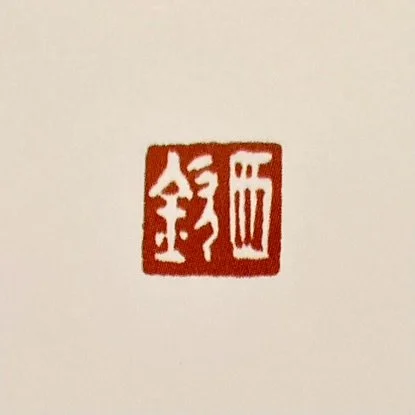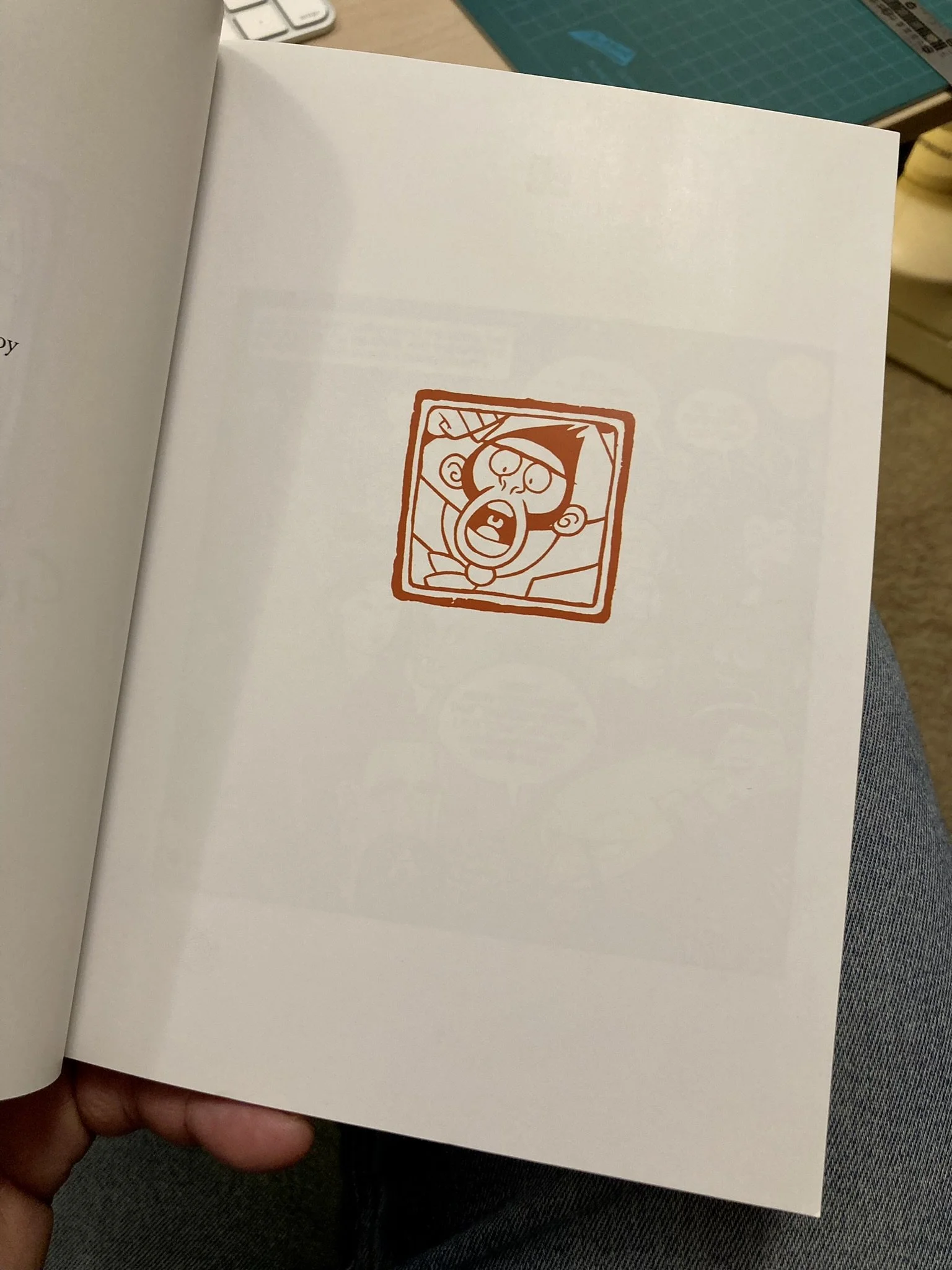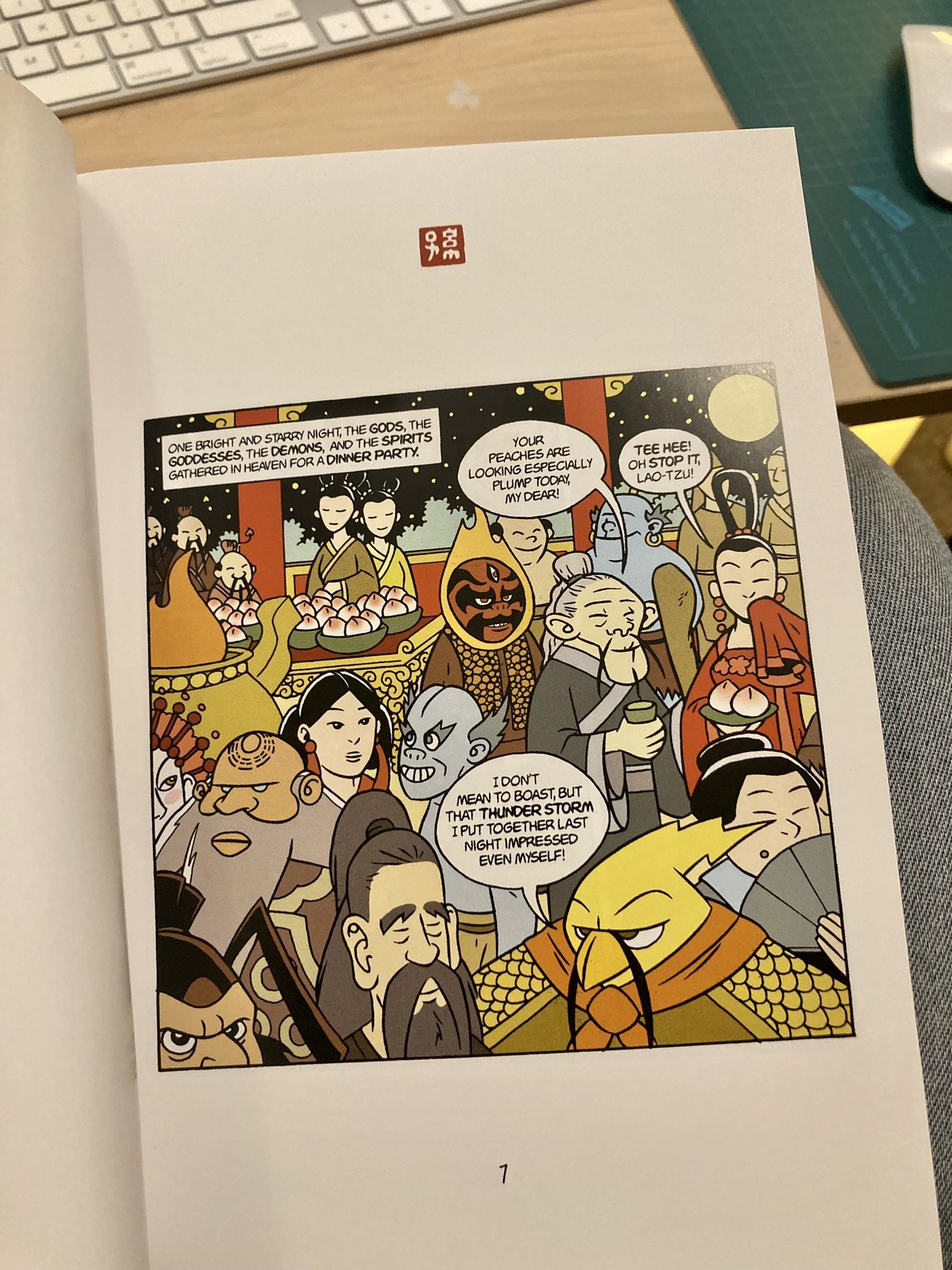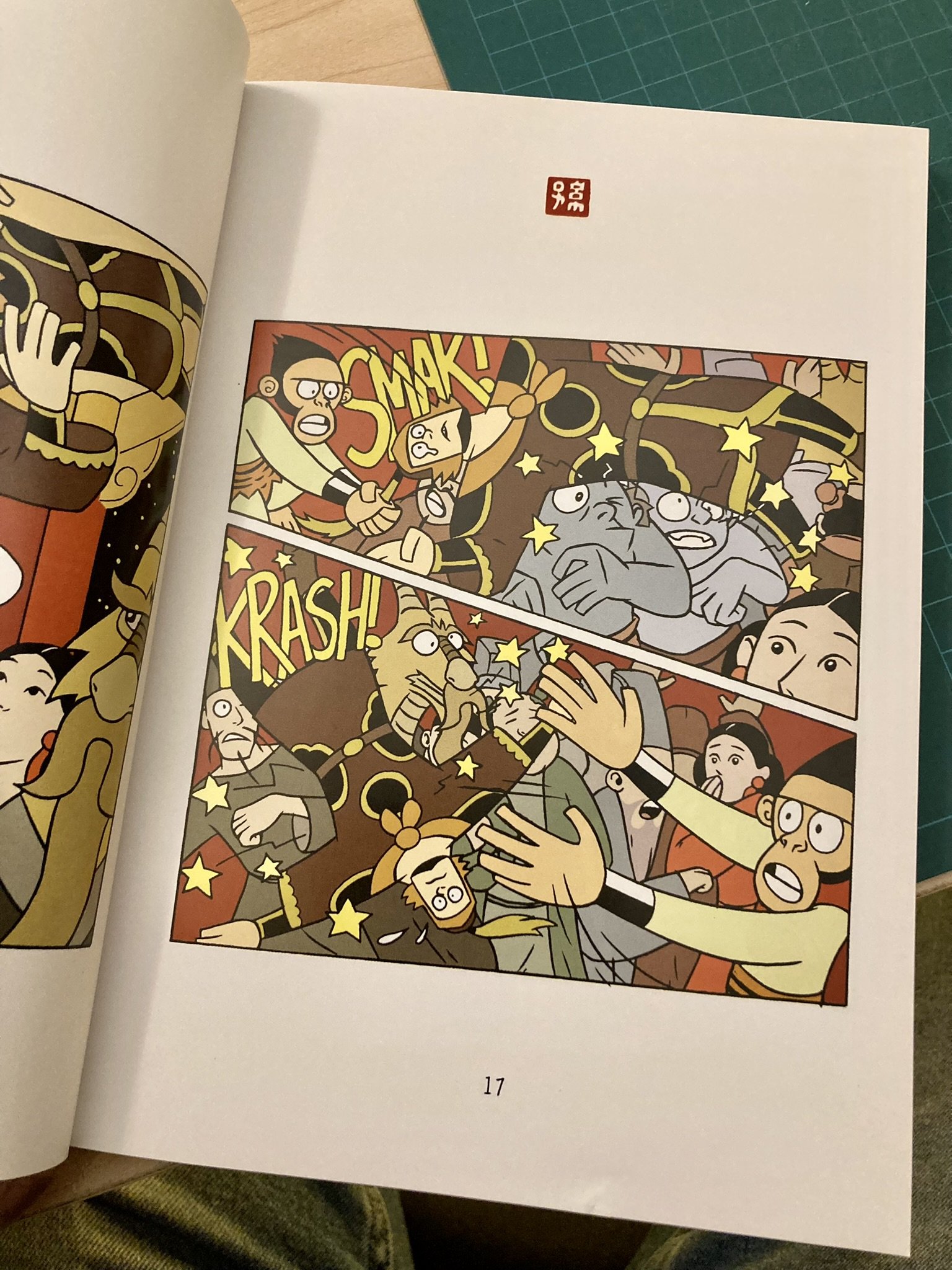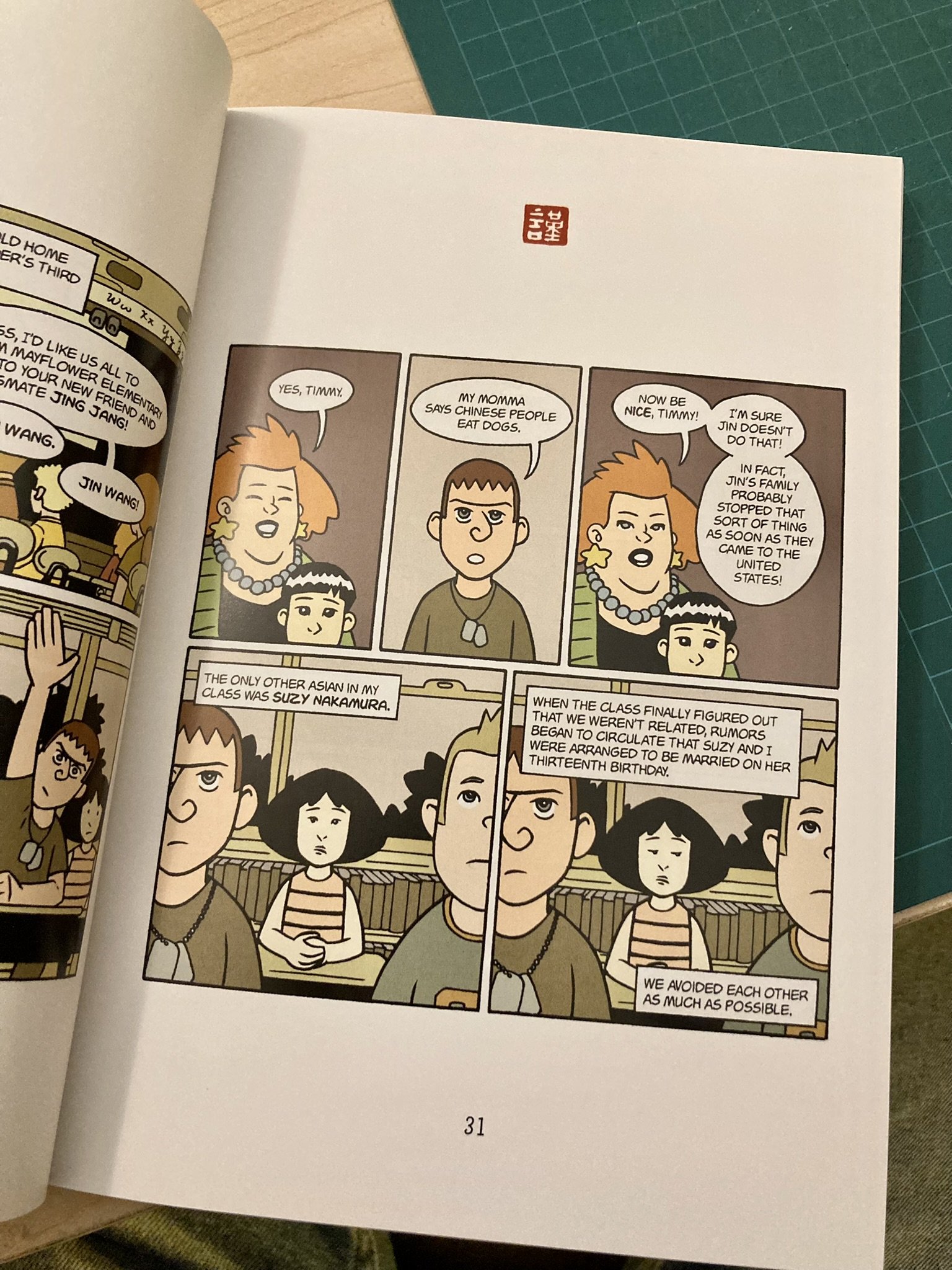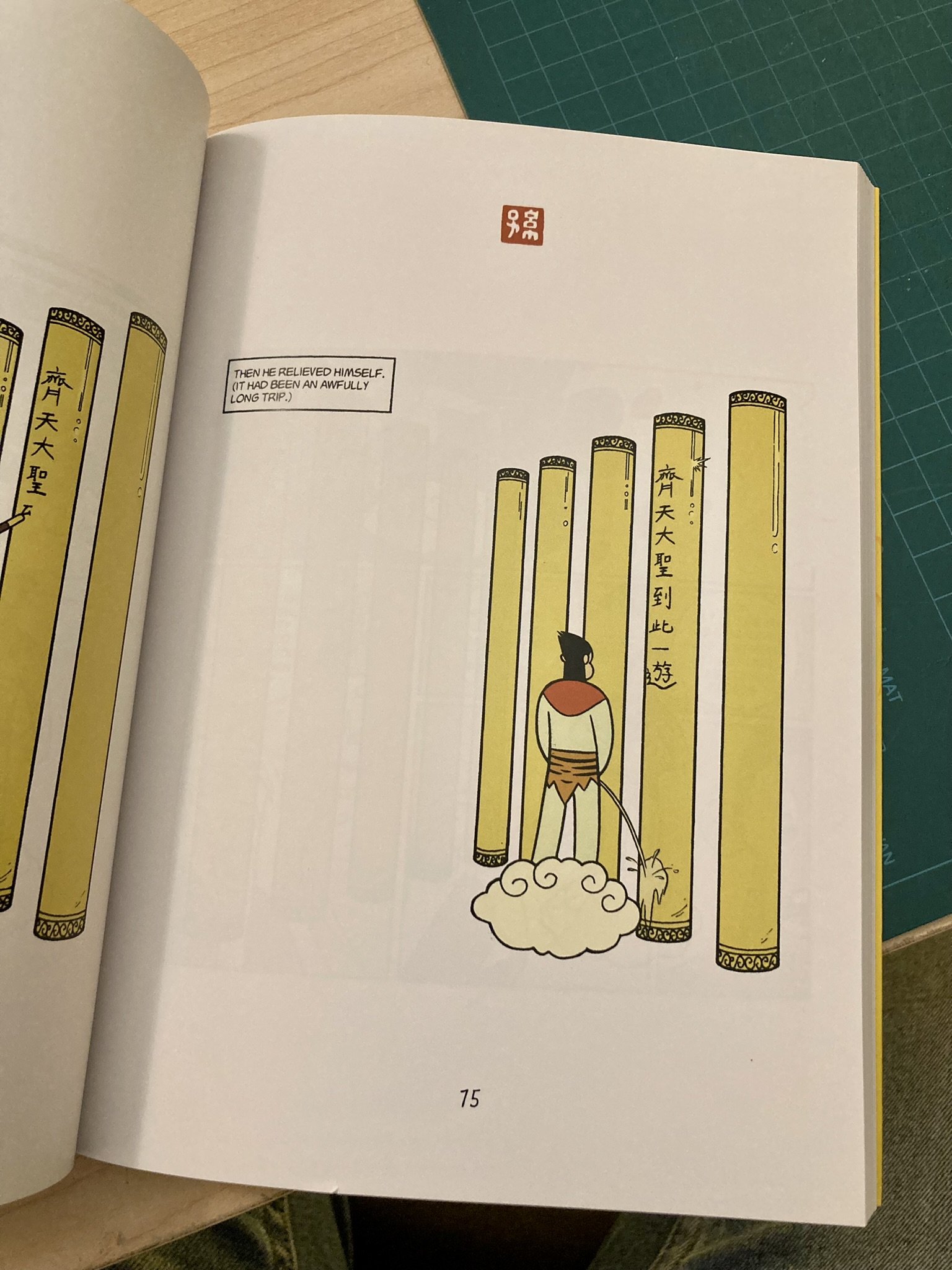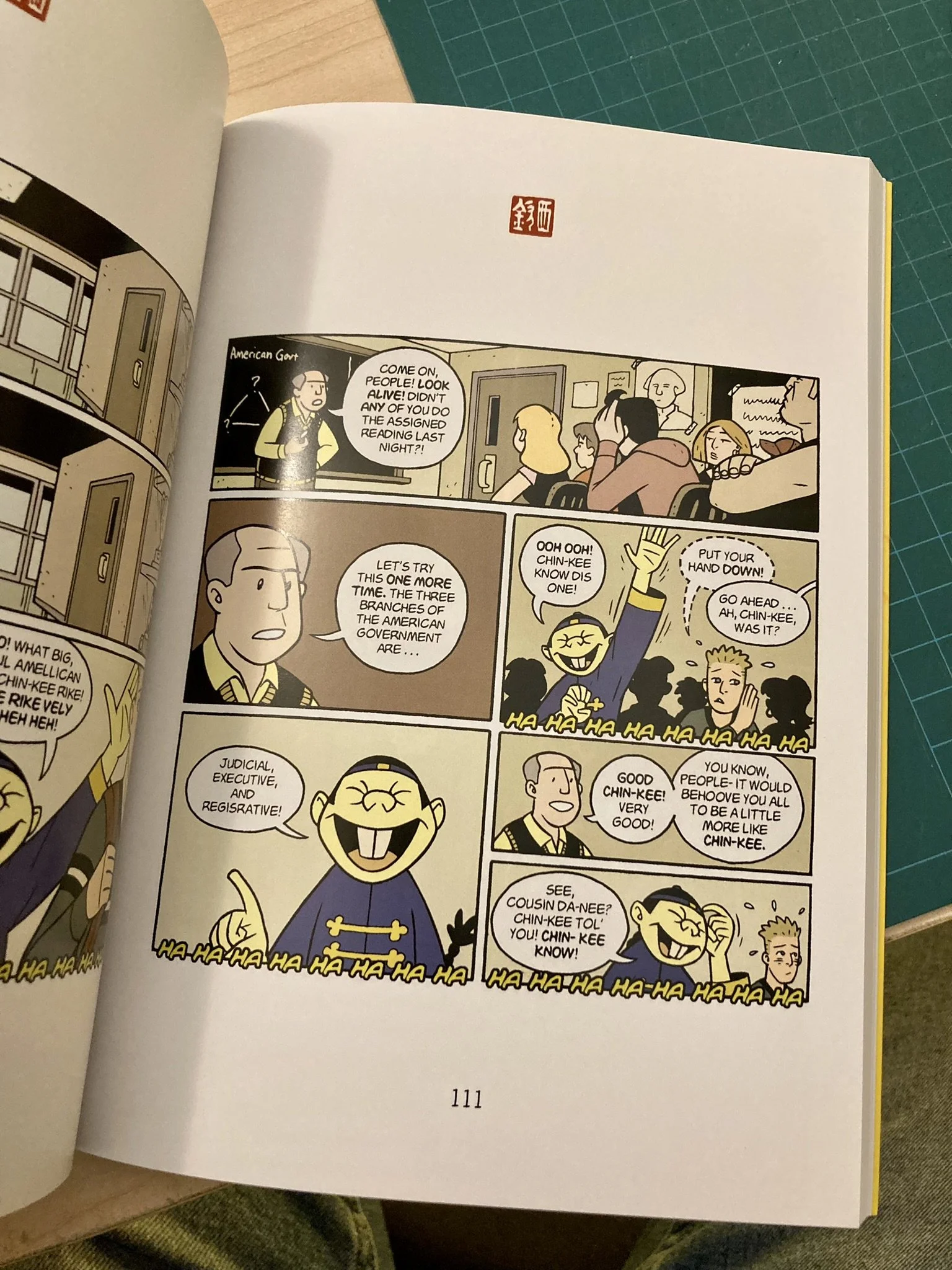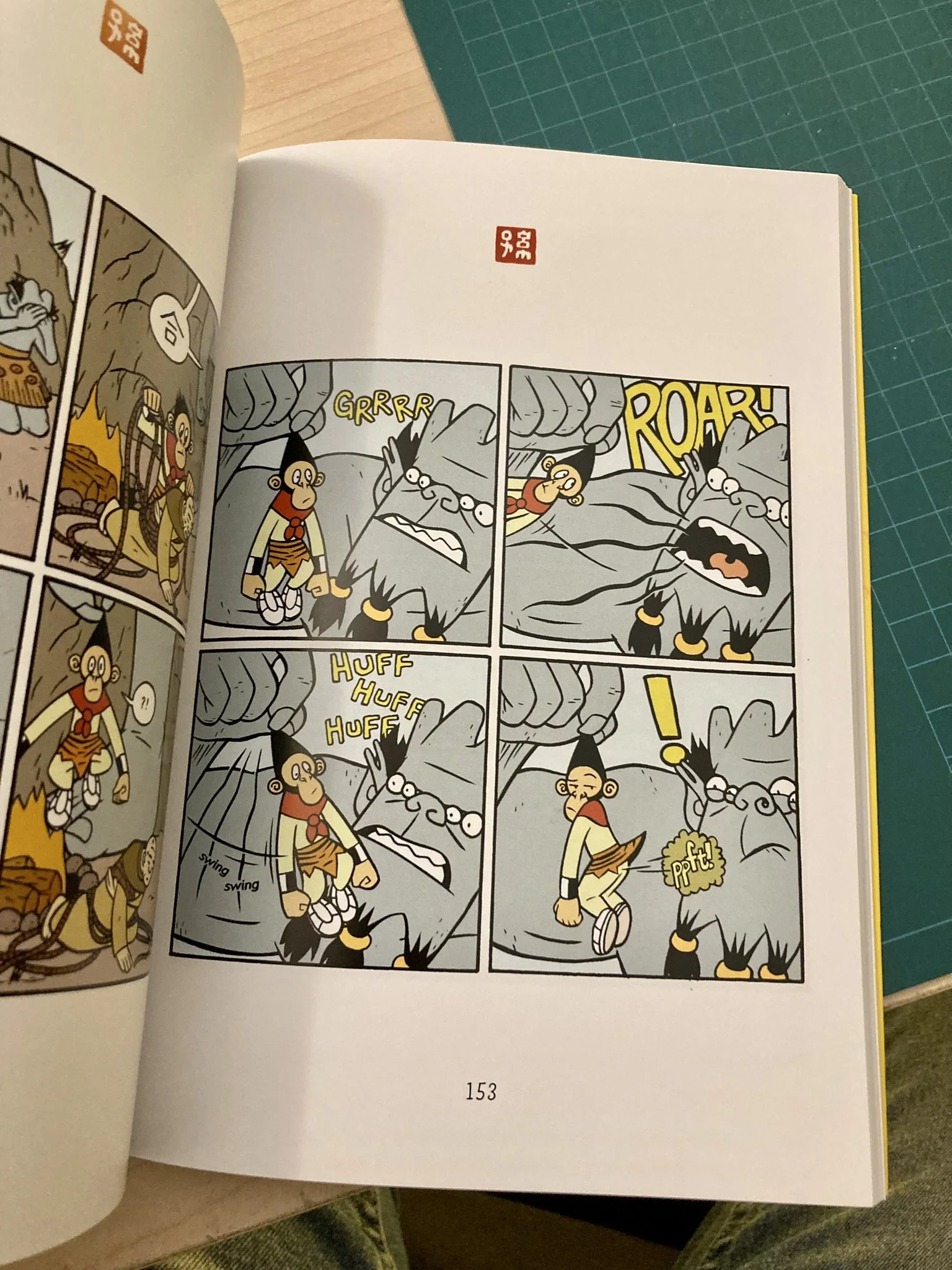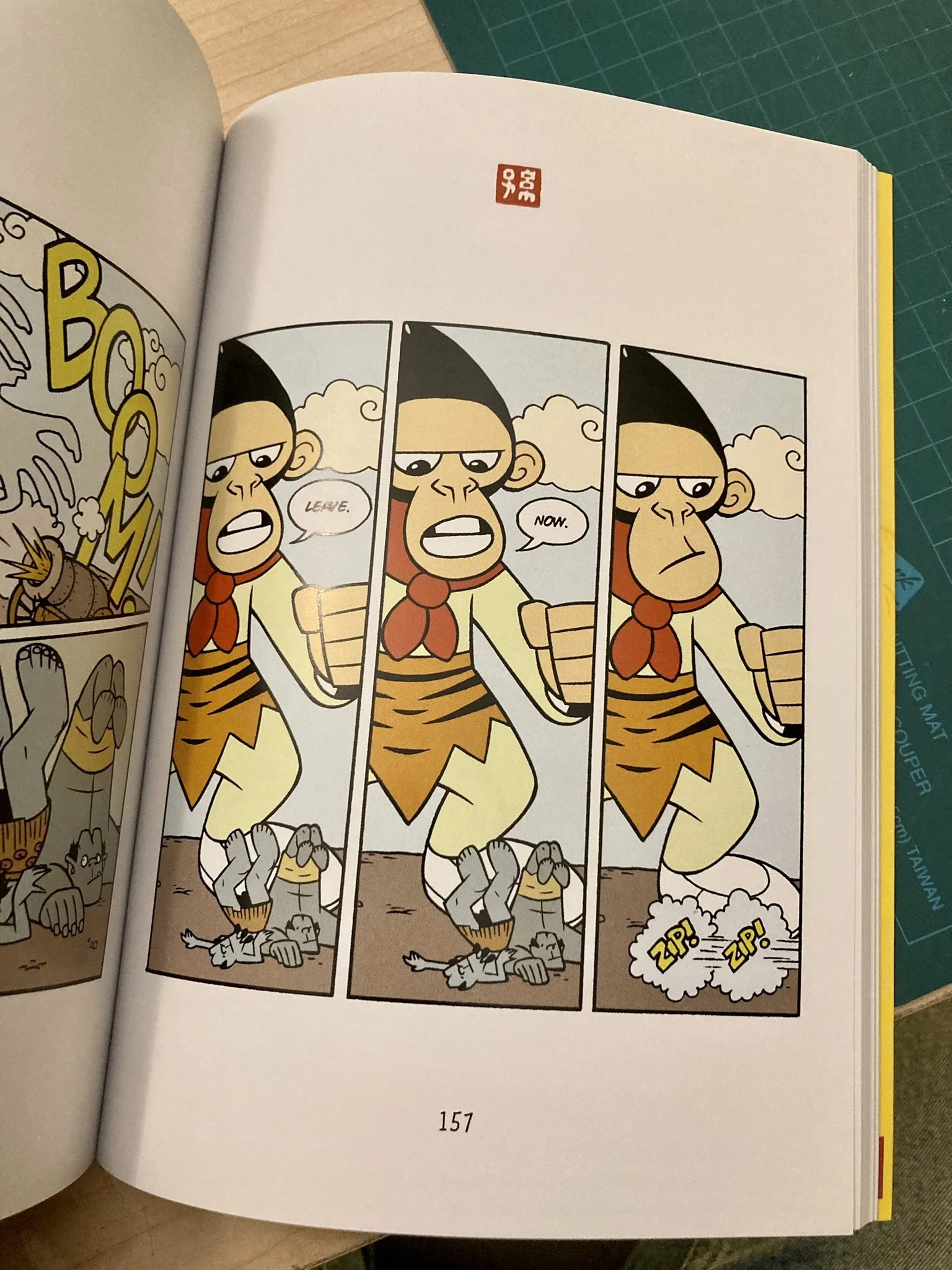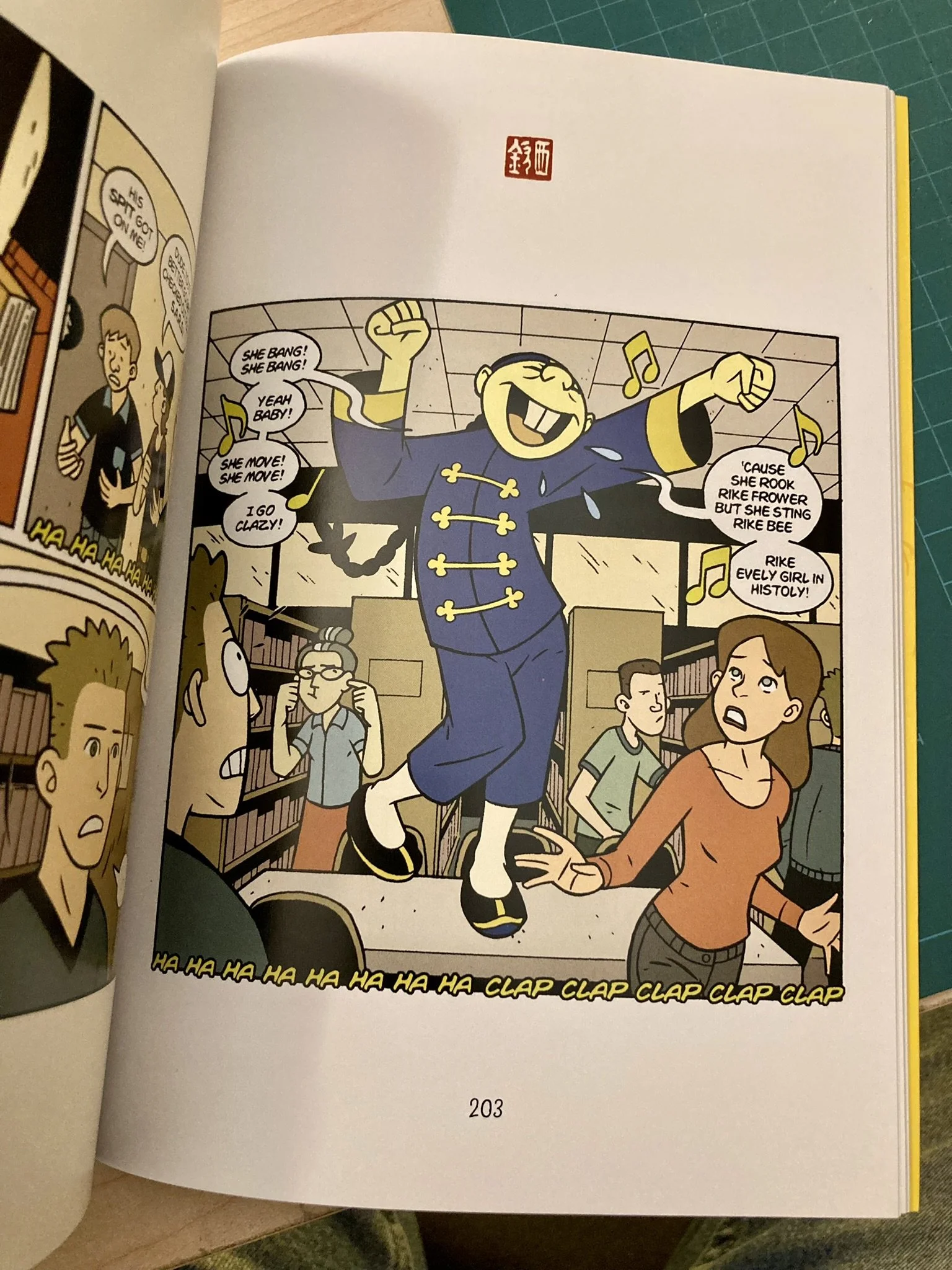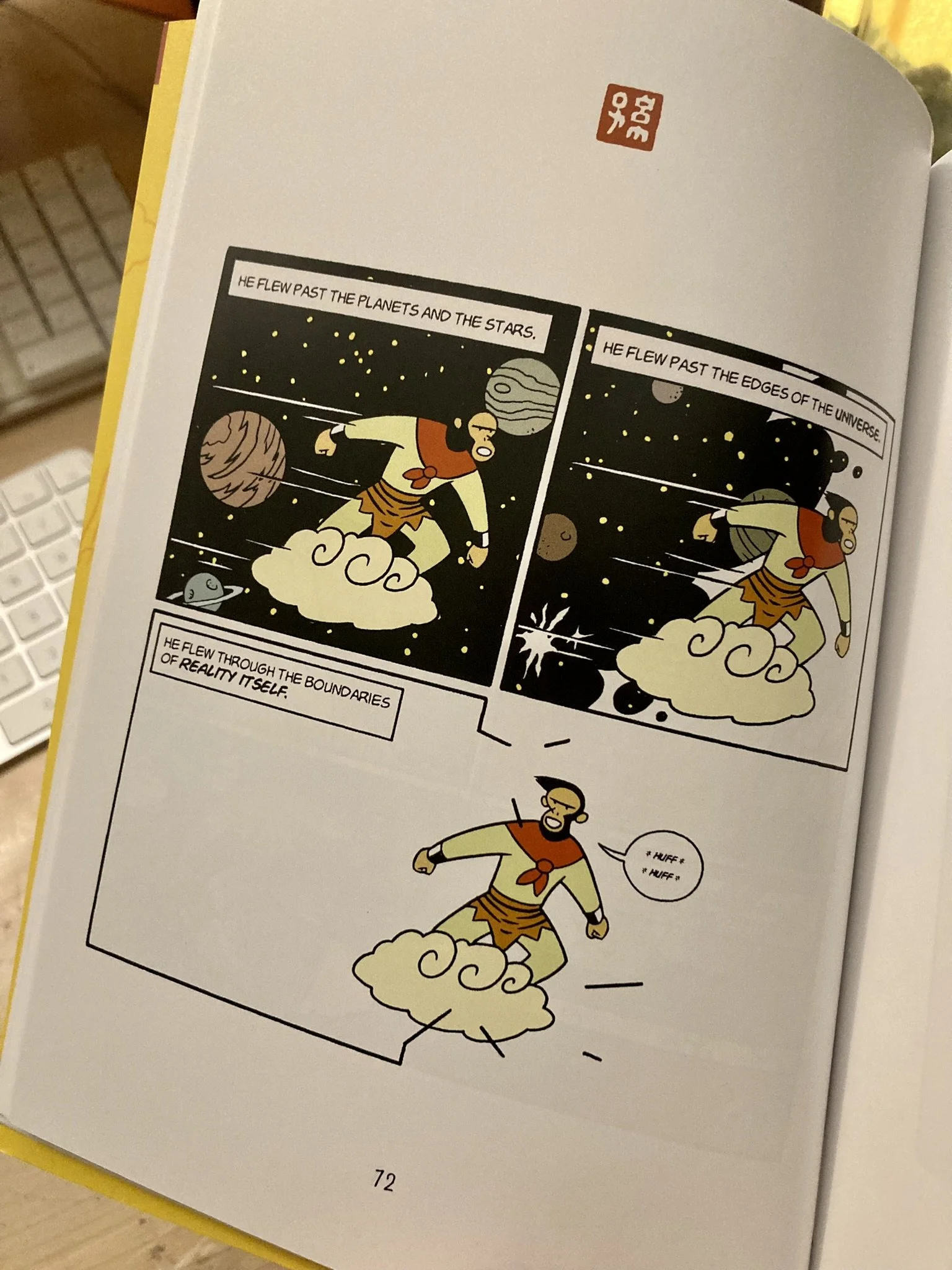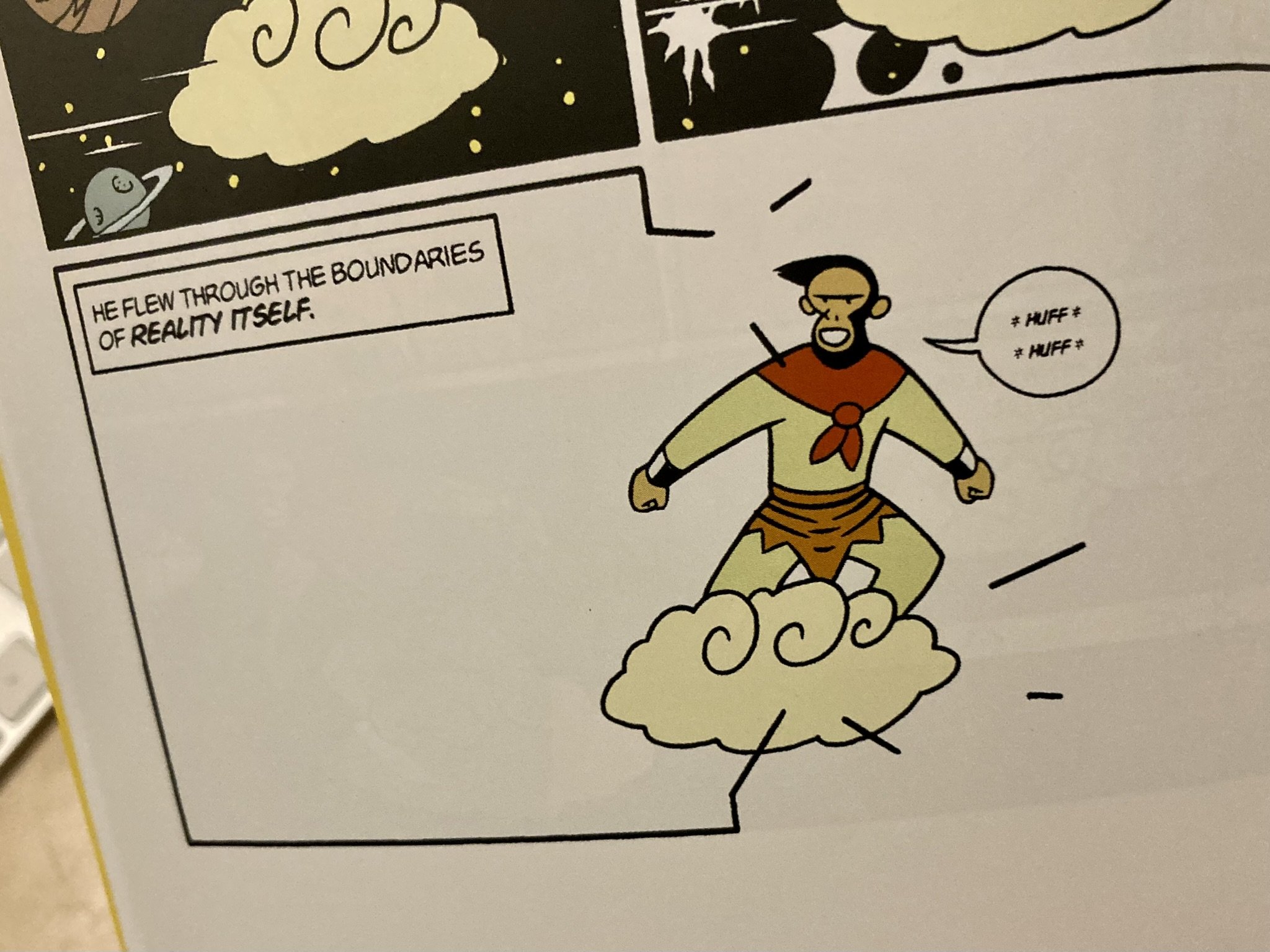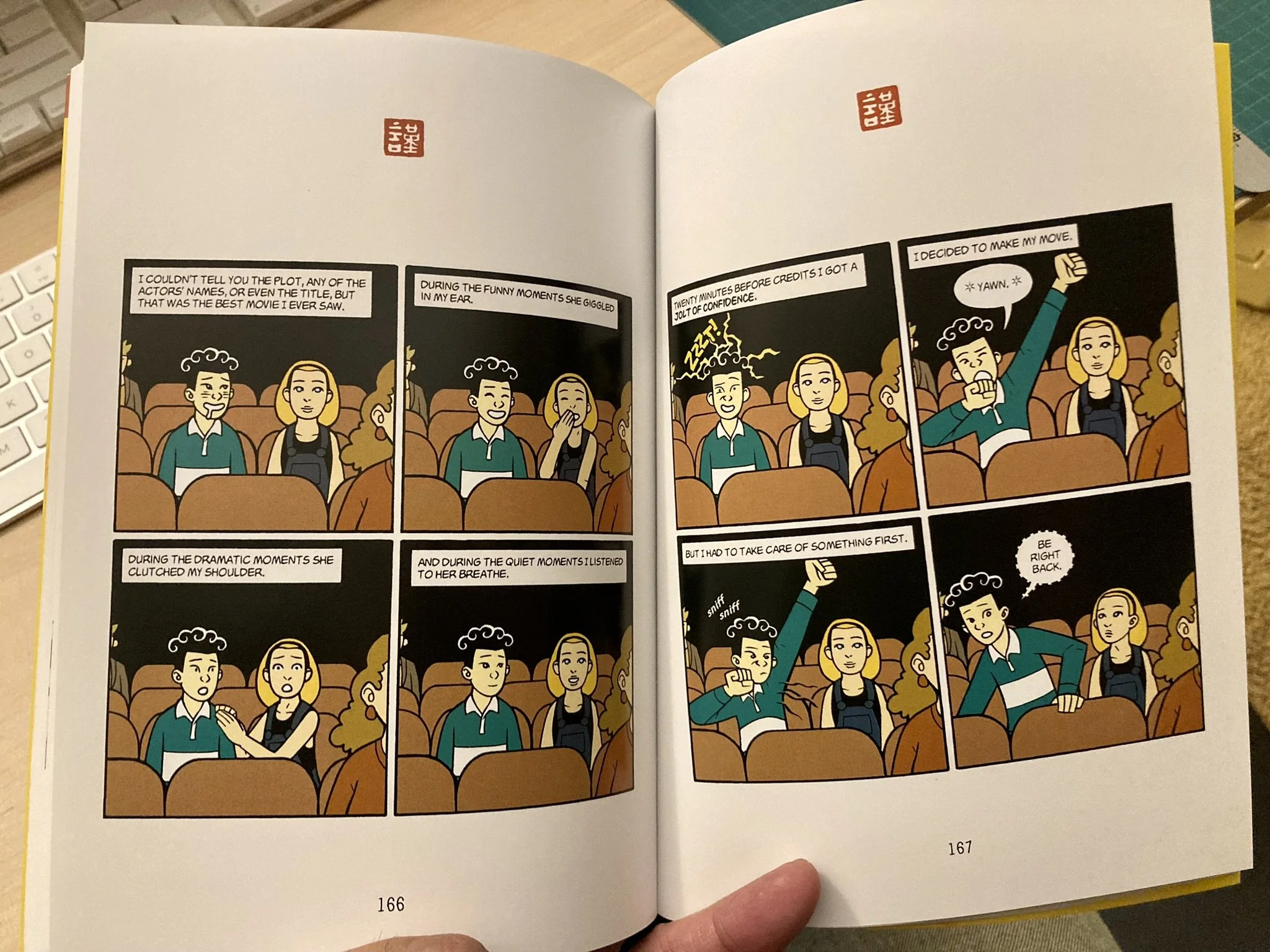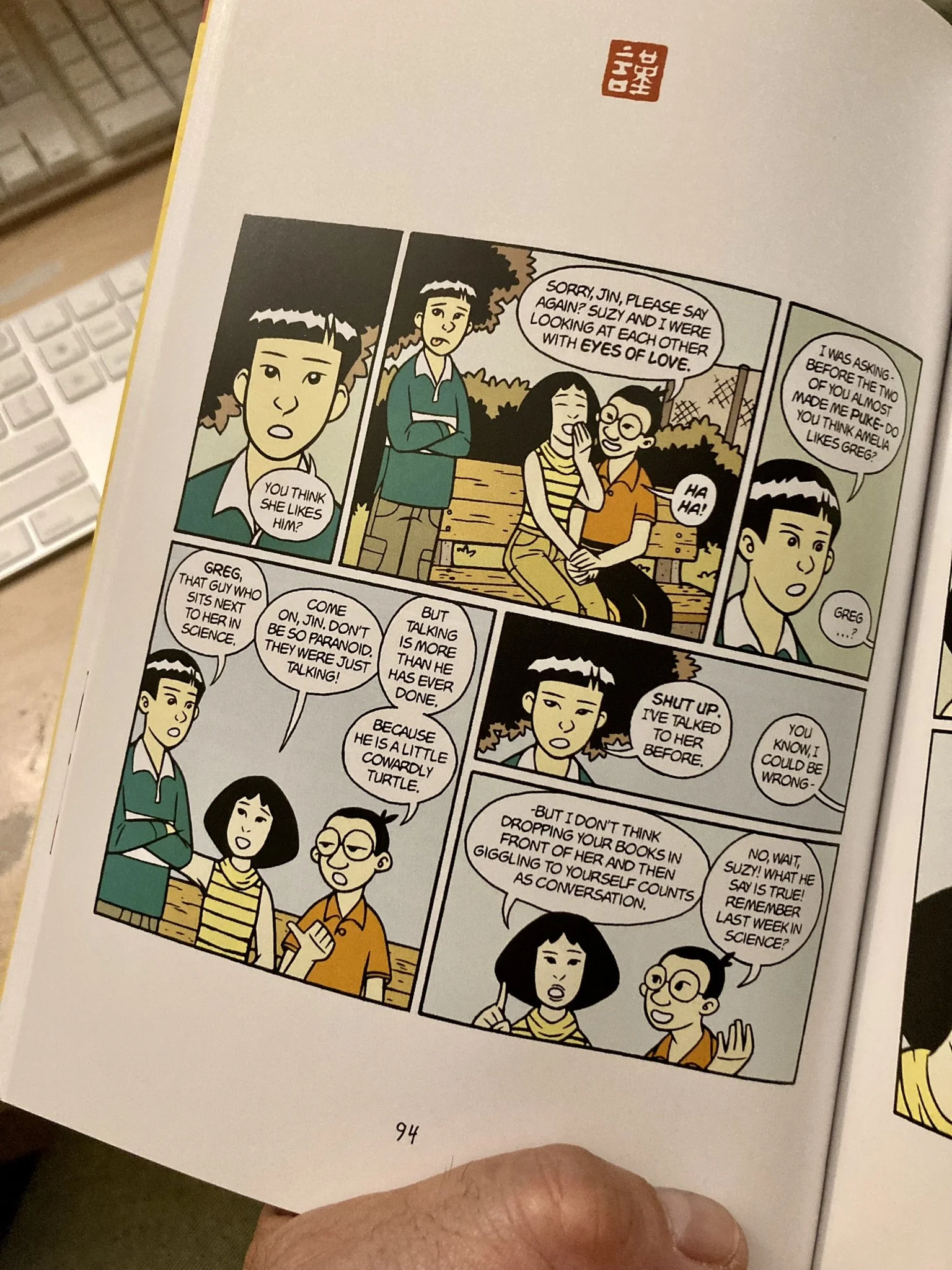Canadian Born Chinese
Today we’re taking a bit of a deeper dive into one graphic novel in particular. And to the surprise of no one who’s been reading our recent posts about our Comic as Object Project or Drawn Together, this will be doing double duty as an assignment for our Head Alien’s LIS 518 course at the University of Alberta School of Library and Information Studies.
As some of you might have already guessed from the title of this post, the graphic novel is called American Born Chinese by Gene Luen Yang.
Introduction
First published in 2006 by First Second Books, an imprint of Roaring Brook Press, American Born Chinese is author/illustrator Gene Luen Yang’s first graphic novel (although not his first foray into comics, but we’ll get back to that!). The supporting cast of creators includes colourist Lark Pien, cover and interior book design by Danica Novgorodoff, editor (and First Second founder) Mark Siegel, and design of the Chinese chops by Guo Ming Chen (more on these later too!).
The book’s publication resulted in critical praise and a long list of awards, not only for Yang but also colourist Pien. And these awards were not only significant in and of themselves, they represent breakthroughs for graphic novels overall. American Born Chinese is the first graphic novel to ever be nominated for an American National Book Award and the first to win the American Library Association's Michael L. Printz Award for young adult literature.
Awards
Finalist for the 2006 National Book Awards in the category of Young People's Literature.
2007 Michael L. Printz Award
2007 Eisner Award for Best New Graphic Album
Publishers Weekly Best Book of the Year
School Library Journal Best Book of the Year
San Francisco Chronicle Best Book of the Year
2006/2007 Best Book Award from The Chinese American Librarians Association
Amazon.com Best Graphic Novel/Comic of the Year.
Booklist Top Ten Graphic Novel for Youth
NPR Holiday Pick
Time Top Ten Comic of the Year
2007 Harvey Award for Best Colorist
The book has also recently been made into a critically acclaimed television series, starring Ben Wang as well as a reunion of Everything Everywhere All at Once stars Michelle Yeoh and Ke Huy Quan.
Origins
Yang describes being motivated to write American Born Chinese as a way to tell his own story, saying in the afterword to the 2021 edition of the book that “I believe that all the stories we tell… collectively make up a millennia-long conversation about what it means to be human. Because my own cultural heritage is such an important part of how I’ve found my place in the world, I knew I had to do a story about it.” On the book’s page in his website, Yang expands on this sentiment, saying that before this book “I never dealt with the Asian-American experience head-on. Since my own ethnic heritage is such an important part of how I understand myself, I knew I wanted to. I came up with three ideas and couldn’t decide which one was the best. American Born Chinese is me doing all three at once.”
Yang explores the background of each of these three storylines in much greater detail in a series of articles in the First Second website: the Origins of American Born Chinese, part 1, part 2, and part 3. Highlights include:
the exploration of the Monkey King mythology in part 1
the echoes to his own life in the storyline of Jin Wang, “a Chinese-American boy growing up in a white suburb,” in contrast to the much more complex “true face of racism” that he actually experienced, and participated in, in part 2
the challenges of drawing and writing the third storyline of Cousin Chin-Kee, a caricature embodying many negative Chinese stereotypes, in part 3.
But behind all that lies an even deeper drive in his choice of the graphic novel medium to tell these interwoven stories. As alluded to earlier, Yang’s career as a cartoonist started many years before the creation and publication of American Born Chinese. On the “About” page of his website, Yang describes starting making comics way back in the fifth grade. On that same page you can also sign up for his email newsletter and receive a bonus comic about how he became a graphic novel and comics artist, and his process for creating them – well worth the sharing of your name and email address. In this bonus comic, titled The Gene Luen Yang Bonus Feature, he describes how he bought his first comic – DC Comics Present #57, featuring Superman and the Atomic Knights – and within weeks “went from reader to creator.” But it wasn’t until the year 2000, 16 years after he first started making comics, that he finally “mustered enough courage” (Yang, Afterword, 2021) to start writing American Born Chinese, his first full graphic novel.
Which brings us back to the graphic novel at hand. Again in his afterword, Yang explains how it took him five years to finish American Born Chinese, and that it was a friend of his who introduced him to First Second founder and editor Mark Siegel, who signed him and published American Born Chinese as part of First Second’s second season of publishing.
And what a book it is.
“Chopped” into chapters…
The first thing I noticed about the book itself is Yang’s use of a very Chinese visual element as a wayfinding tool. I mentioned earlier the specific listing of Guo Ming Chen as the designer of the Chinese ‘chops’ used in the book, and I am delighted to boost their name again now. They play a huge part in the visual language of this book.
Carved Chinese chops or seals, stamped onto artwork and documents in red ink, are used in the way ‘western’ culture uses a signature to sign documents, artwork, and other paperwork (here’s a great article on Chinese chops if you want to learn more about that!). But in American Born Chinese, Yang uses the chops belonging to each of the three main characters to literally stamp every page that features their respective storylines. And he begins each chapter with an illustration of each of the three characters done in a very similar chop-inspired style.
Introducing the Monkey King, and his chop…
… Jin Wang, our “Chinese-American boy growing up in a white suburb,” and his chop…
… and finally Chin-Kee – and yes, Yang went there, with the stereotyped character being named ‘Chinky’ – and his chop…
Each chapter begins with a page featuring only the ‘profile pic’ of the character whose point of view we will be following in that chapter, completely blank on the reverse so that each chapter always then begins with our focus entirely on the one image on the right hand page…
Then every page within that chapter features that character’s chop at the top center of the page, then the square footprint of actual comic below a comfortable stretch of white space, and finally a page number at the bottom.
And Yang never breaks this underlying grid frame, even as he subdivides the panel area in multiple ways…
Even on the one occasion when Yang ‘breaks a wall,’ both literally and figuratively, as the Monkey King “flew through the boundaries of reality itself,” Yang still does so within the allotted space for the panel(s) on the page.
And in perhaps the subtlest of visual touches… in the final chapter of the book, identified on the chapter break page as being Chin-Kee’s… when <spoiler alert> Chin-Kee reveals himself to be in reality the Monkey King in disguise, whose white cousin Danny we had recently discovered was actually <spoiler alert> Jin Wang transformed into a white person… when the Monkey King says to Danny “now that I’ve revealed my true form, perhaps it is time to reveal yours,” turning the page not only shows a panel of Danny morphing back into Jin Wang, but the chop at the top of the page also becomes Jin Wang’s, the first and only time a chop changes mid-chapter.
… subdivision into different shapes and sizes to reflect the pace and flow of conversation…
… and single full page panels, especially at the end of chapters to summarize or close off the chapter…
This variety includes Yang’s use of angled panel divisions specifically, and very effectively, only for scenes of violence…
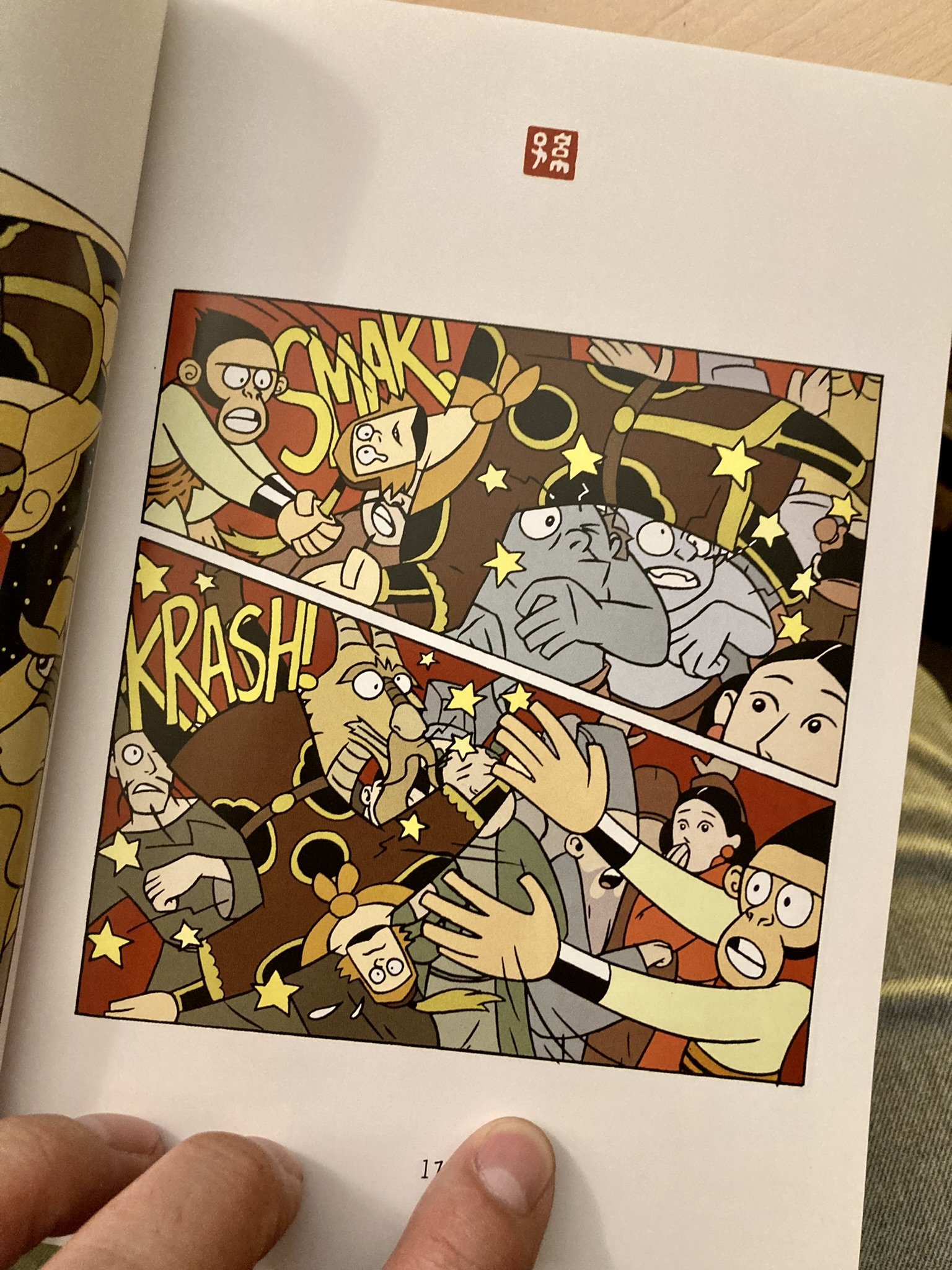
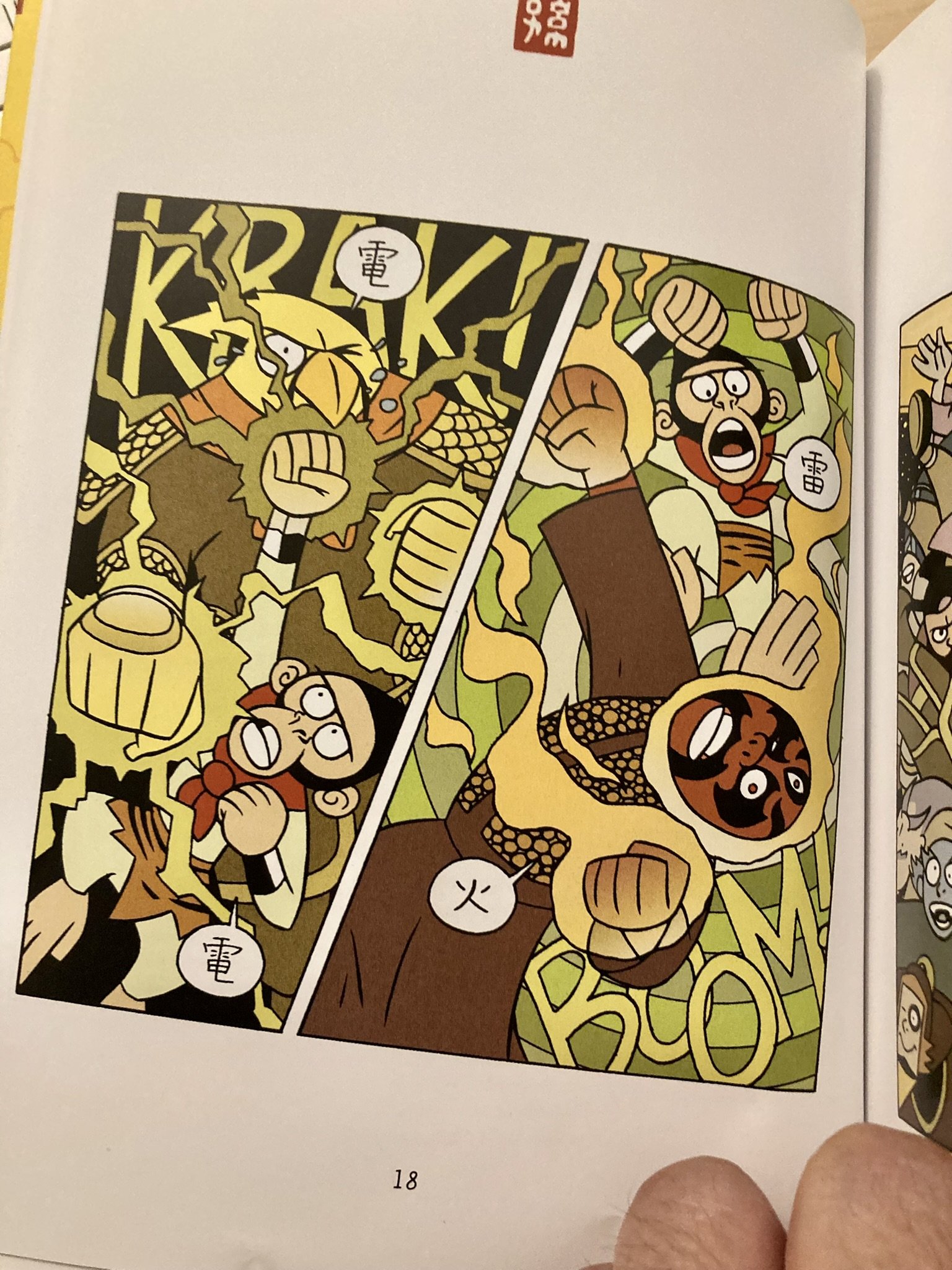
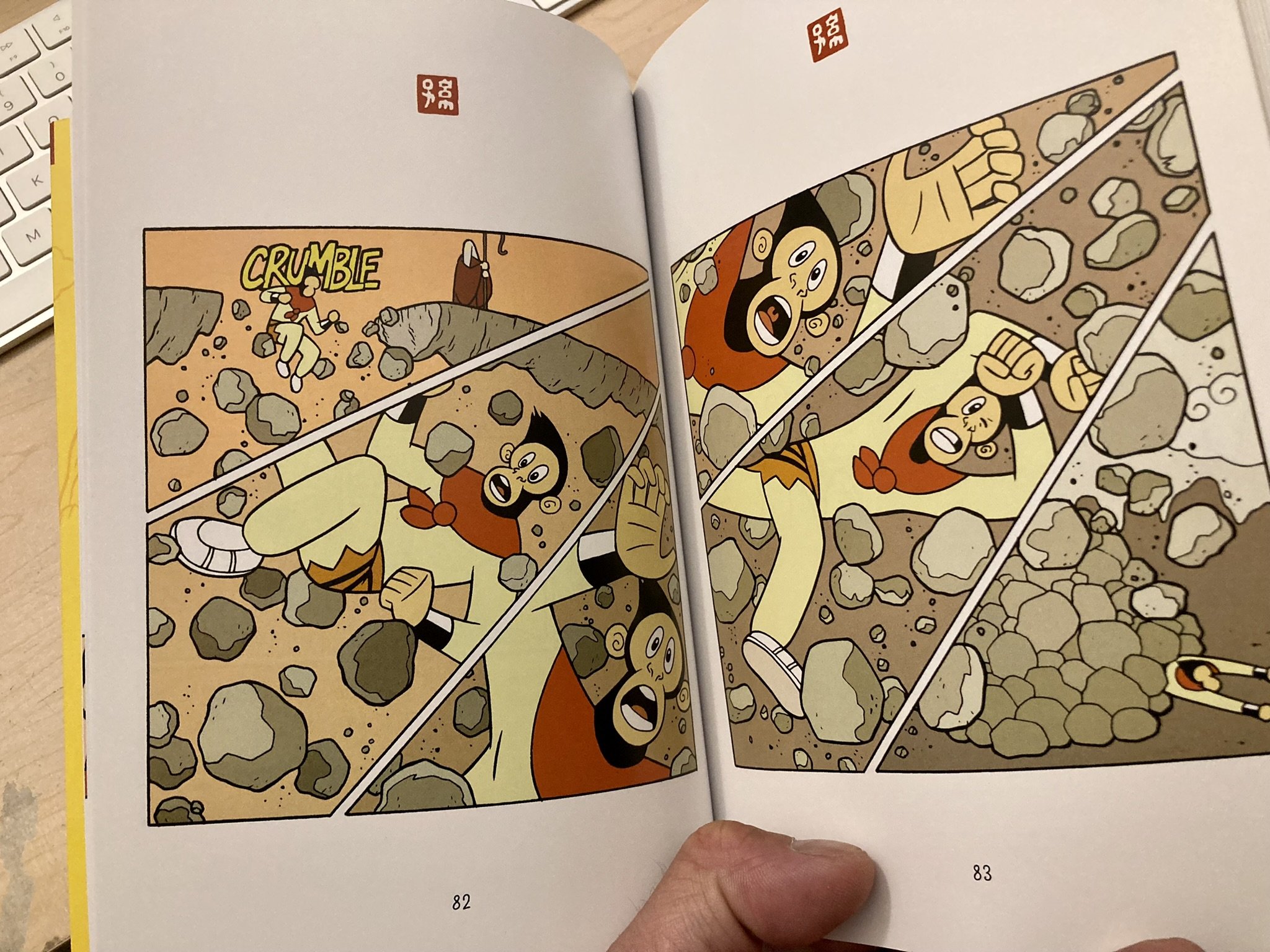
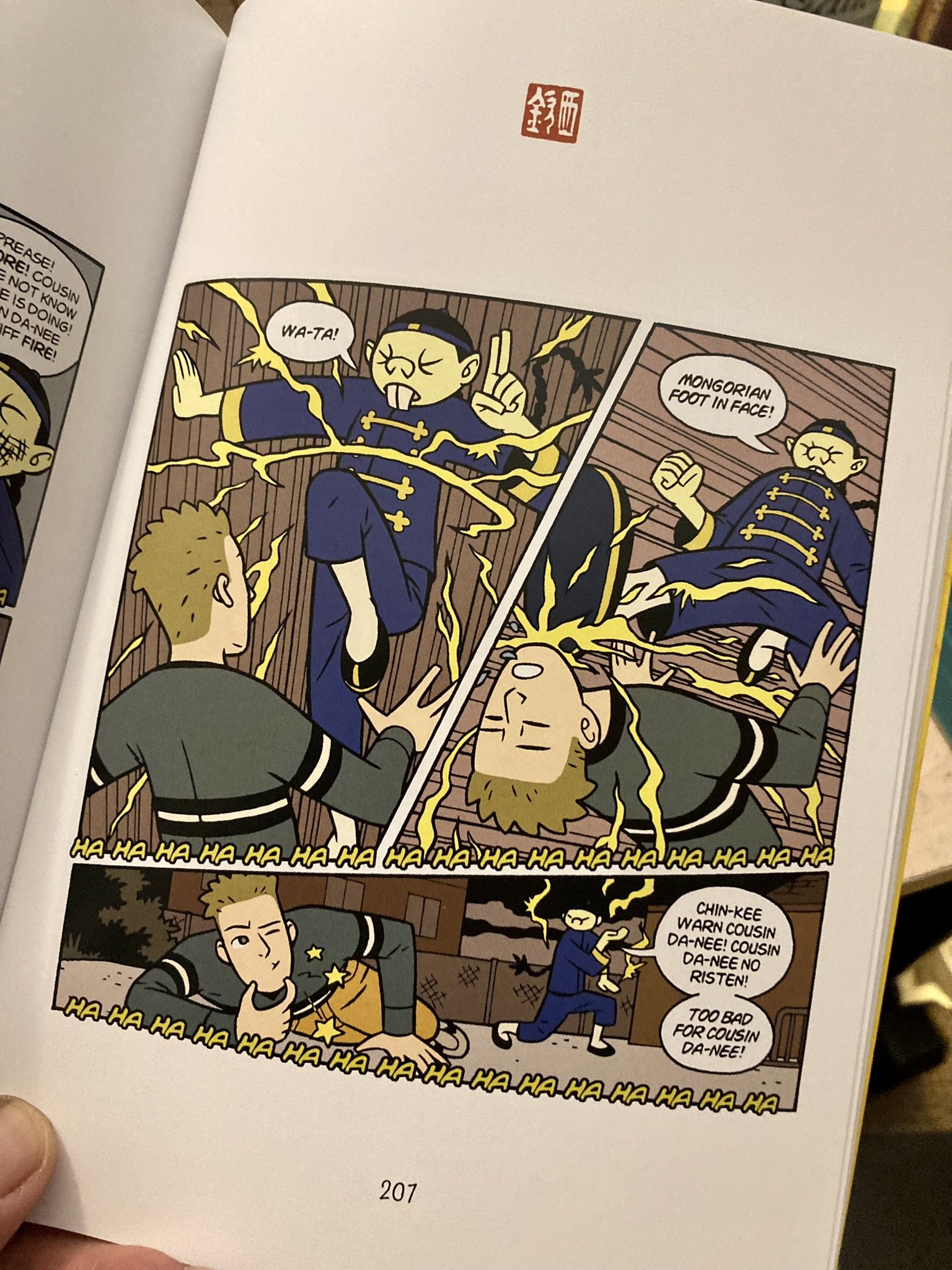
And in another interesting panel division technique, Yang introduces an… ornamental?… textual border with the introduction of Chin-Kee that is what I will describe as ‘visually annoying,’ in keeping with the way Chin-Kee is depicted as annoying. It also evokes the kind of laugh track and ‘live studio audience’ clapping of over-the-top television sitcoms that is also in keeping with the over-the-top depiction of Chin-Kee…


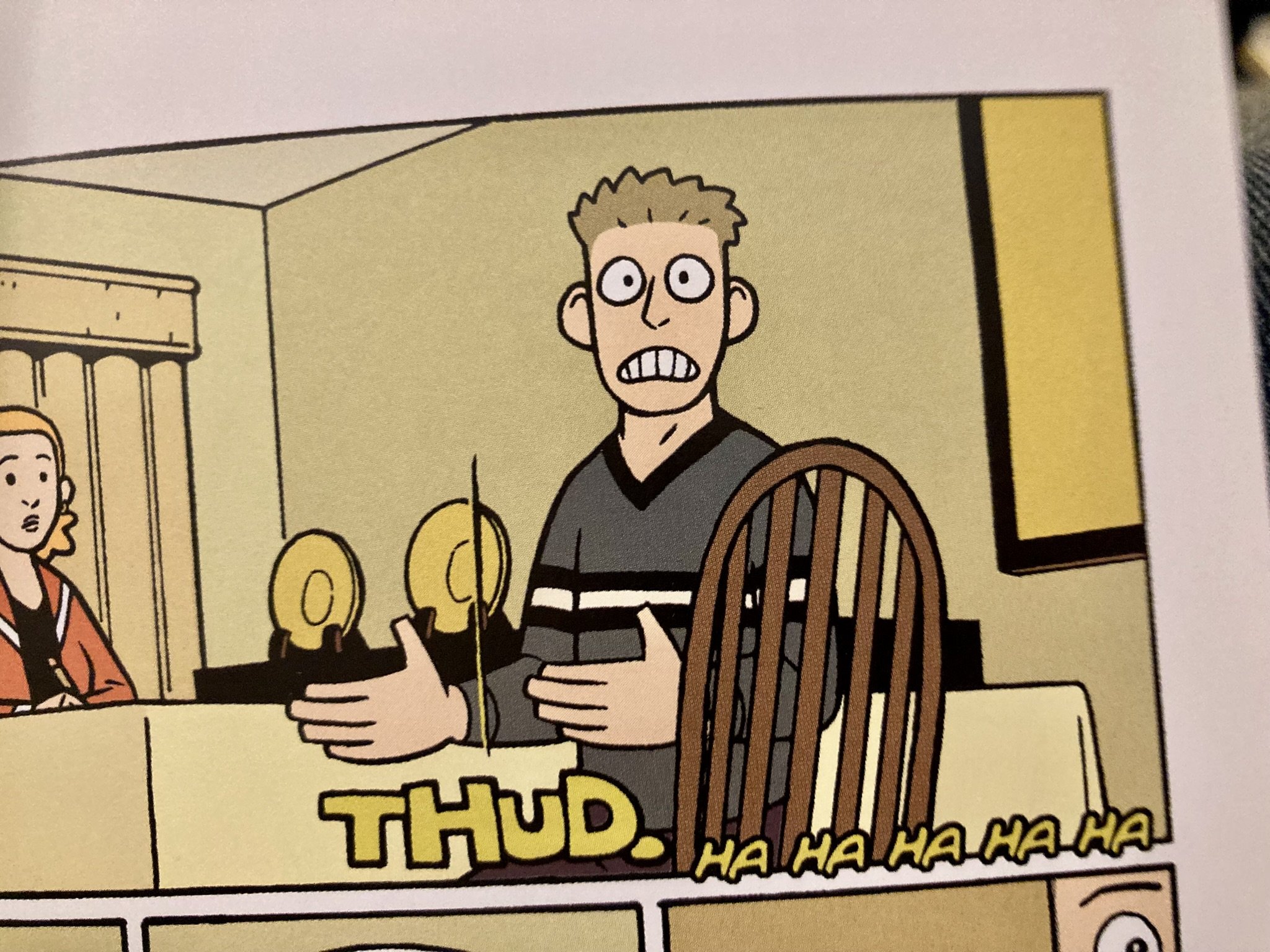
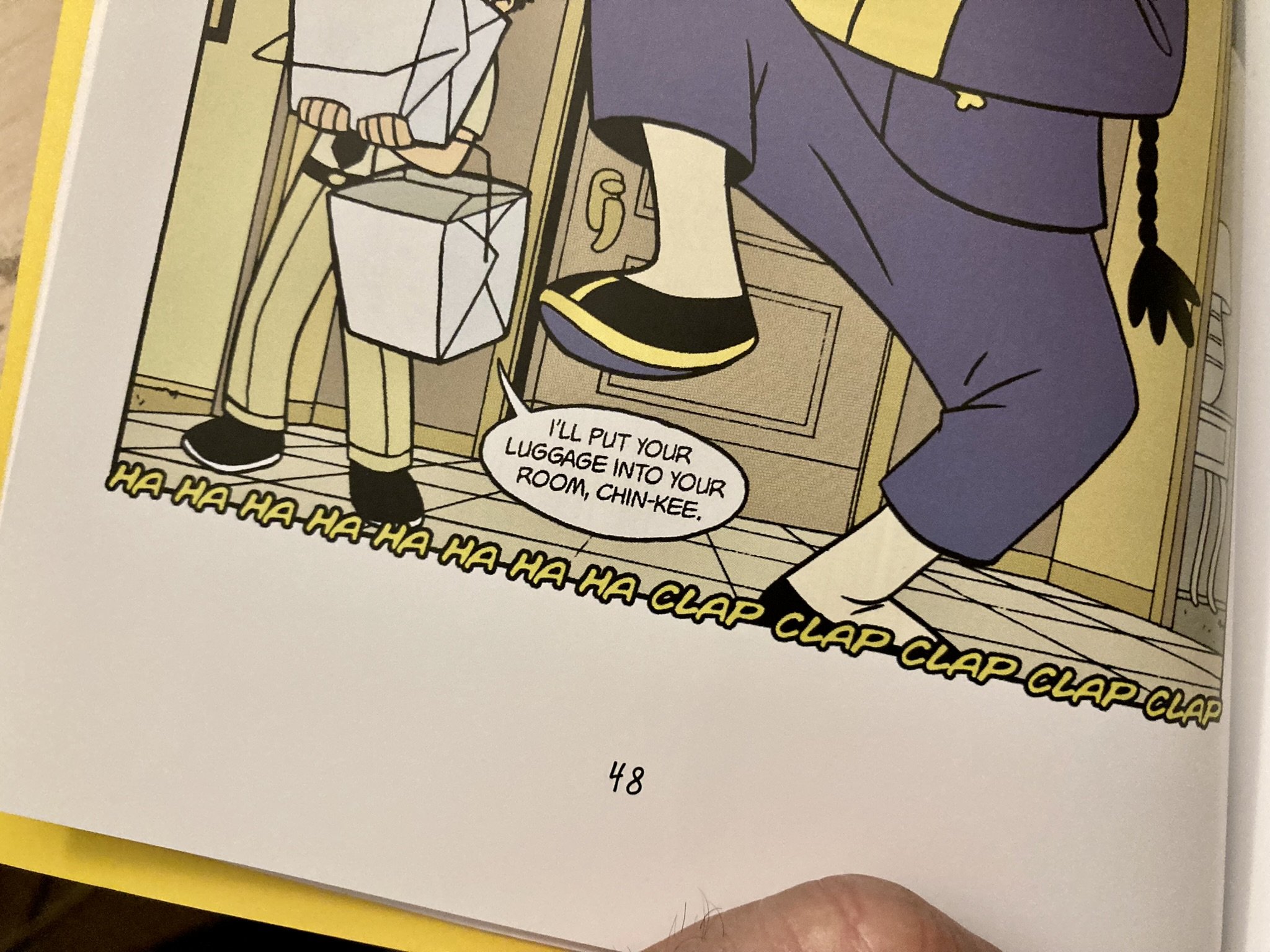
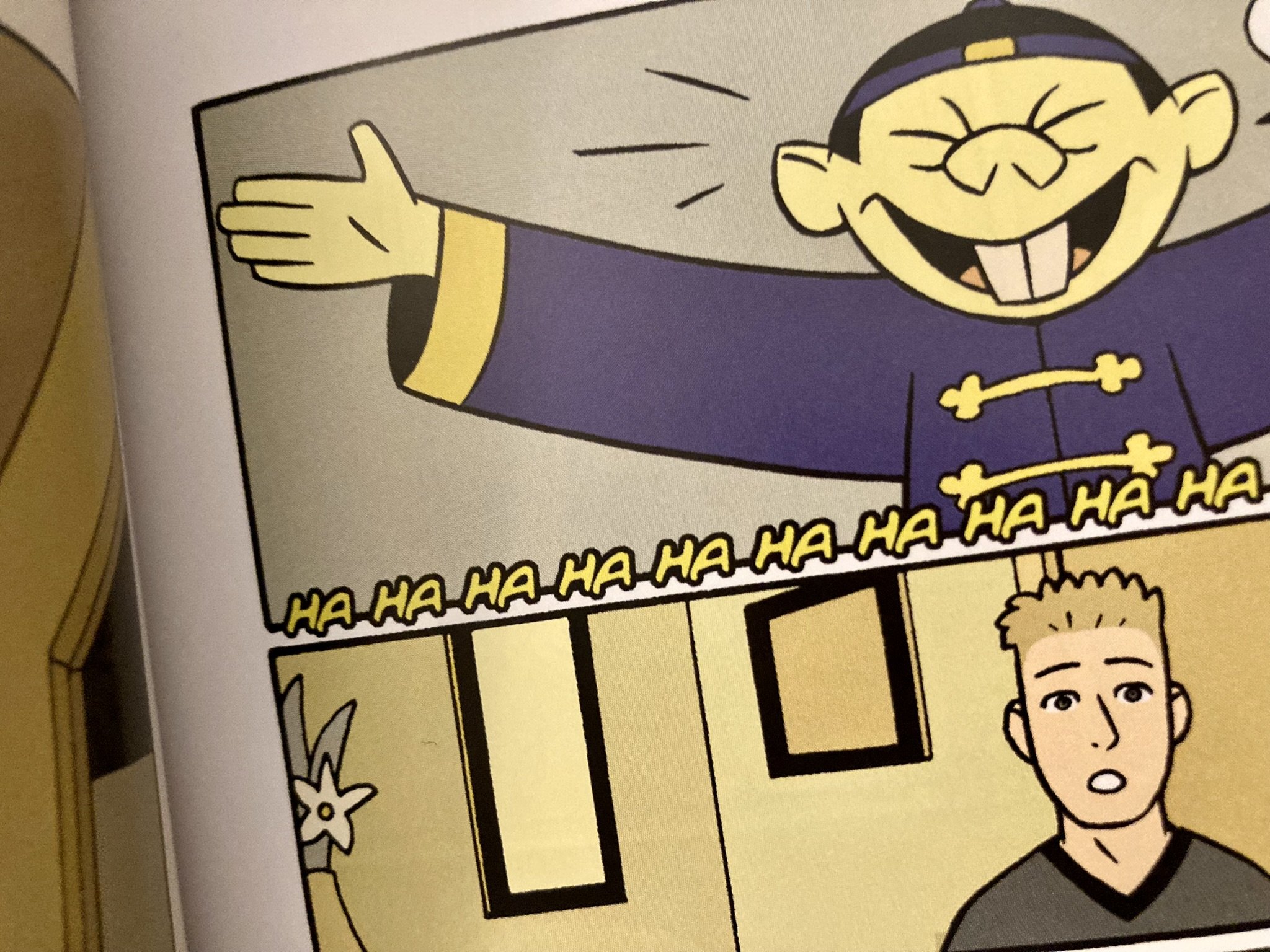
And yet unified…
And yet, taken together, all these visual elements complement and reinforce one another remarkably well. The resulting effect, for me at least, is a combination of a clear consistency of vision throughout, but with an equally clear if subtle sense of whose point of view and storyline we’re experiencing on any given page. Further reinforced by Yang’s distinct drawing style and Pien’s use of colour, this consistency visually unifies the book even as it shifts narratively between three alternating storylines.
But, indeed, the visual consistency and subtlety is perhaps the intended and desired overall visual effect in that the three storylines do eventually resolve into one as well.
All in all, Yang’s deft handling of the visual medium plays a critical part in the success of this graphic novel, complementing and enhancing his equally skilled storytelling in so many ways.
The critical response
As demonstrated in the list of awards above, the critical response to American Born Chinese was strongly positive.
A review in the Library Journal describes Yang’s artwork as “simple, colorful, and both attractive and effective.” Publishers Weekly says “this story's clear, concise lines and expert coloring are deceptively simple yet expressive.” A review in the School Library Journal says “Yang's crisp line drawings, linear panel arrangement, and muted colors provide a strong visual complement to the textual narrative.”
Thematically, the response was as positive. The same School Library Journal review comments on how the three storylines “converge into a satisfying coming-of-age novel that aptly blends traditional Chinese fables and legends with bathroom humor, action figures, and playground politics… in a finely wrought story that is an effective combination of humor and drama.” Publishers Weekly calls it “a fable for every kid born into a body and a life they wished they could escape.”
Reviewer B. Fu goes into even more depth in their MELUS review, saying that “Gene Luen Yang’s new graphic novel might have just changed the tide in a significant way” on the “racial degradation” and “racially biased, dehumanizing comic gallery of Asian Americans” that has dominated graphic literature in the American mainstream media. Fu calls American Born Chinese “mature in artistic appeal and visually engaging” but then goes on to say that “what makes it especially appealing to both young and mature readers is its narrative depth,” followed by a detailed thematic analysis of the story. They conclude by saying that Yang’s work might even “perhaps transform Asian Americans’ view of the graphic novel as a medium that can liberate more than it restrains.”
But it’s a review in the English Journal that I think best describes how well Yang specifically uses the graphic novel format to weave together this three-in-one tale of trying to find one’s place in the world, using both text and image. Reviewer J. Blasingame Jr. calls American Born Chinese a “seamless blend of three genres: a Chinese fable, a realistic/problem novel, and a parody/satire.” They continue, describing how by “using facial expressions and body gestures, and by varying the angle of perspective, Yang provides information that goes beyond what the print text can offer.” For example, they mention visual cues such as similar hairstyles on seemingly disconnected characters as another visual clue to the interconnections between stories.
Blasingame concludes by saying that “American Born Chinese is both comical and heart-wrenching… The pacing has the quickness afforded by a graphic format, facilitating and adding to the reading. Yang is not only a brilliant storyteller but also a gifted cartoonist, and the synergy of these two talents makes American Born Chinese more than it could have been just as a print-text book.”
Echoes north of the 49th
As suggested by the title of this post, there was a lot I found familiar in American Born Chinese, in both the author and the book. I actually picked up this book a year before taking LIS 518, long before I even knew I was going to be taking the course. But my reasons for picking it up reflect themes we have studied in depth in the course, in particular on representation in comics and graphic novels.
Like Yang, I grew up on the stories of the Monkey King. I also grew up as a Chinese kid in what was essentially a predominantly white suburb. And in learning more about Yang through his article on the origins of American Born Chinese, I even discovered that I, like him, “looked much more like one of [Jin Wang’s] friends from the Chinatown apartment building” than Jin Wang himself. Even while keeping in mind the critical understanding that no group or category of people is a monolith, the fact remains that there was a recognition of the familiar to me where it would not be for many.
So while a number of other graphic novels that we studied in the course – including The Magic Fish by Trung Le Nguyen, New Kid by Jerry Craft, Borders by Thomas King, and Wash Day Diaries by Jamila Rowser – gave me insight into why representation is so important, it’s American Born Chinese in particular that brought it home.
And yet at the same time, there is also something universal about the stories being told in all of these graphic novels. In the afterword to American Born Chinese, Yang shares about that effect in particular:
Again and again, readers would approach me… to tell me their own experiences of being outsiders.
Many of them were the children of immigrants like me, though their parents might have come from India, Nigeria, Russia, or Mexico. Others found themselves on the outside for different reasons. Perhaps it was because of their sexual orientation or their faith tradition or the unconventional way their brain worked.
It didn’t matter. The details might have been different, but the emotions were always the same.
So, yes, there is much I could say about exactly how Yang… and Jin Wang and Wei-Chen and Danny and the Monkey King… are or aren’t like me, and why American Born Chinese was particularly powerful for me. And also about how more subtle or indirect forms of representation are important too. But I don’t think that’s quite the point, at least not the biggest one for me… for me and this book.
Instead, maybe what I will do is show you.
I think for me, it was as simple as the fact that when I saw this…
… I immediately saw this…
And maybe that’s the only explanation that’s needed.
Happy reading!
– Winston
Works Cited and Consulted
American Born Chinese (graphic novel). (2023, 21 June). In Wikipedia. https://en.wikipedia.org/wiki/American_Born_Chinese_(graphic_novel)
American Born Chinese (TV series). (2023, July 24). In Wikipedia. https://en.wikipedia.org/wiki/American_Born_Chinese_(TV_series)
American Born Chinese. (2006). Publishers Weekly, 253(24), 36–37. https://www.publishersweekly.com/9781596431522
American Born Chinese. (n.d.) IMDb. https://www.imdb.com/title/tt15552018/
Berman, M. (n.d.). Parents' Guide to American Born Chinese. Common Sense Media. https://www.commonsensemedia.org/book-reviews/american-born-chinese
Blasingame Jr., J. (2007). American Born Chinese. English Journal, 97(1), 99.
Cornog, M. (2007). American Born Chinese. Library Journal, 132(5), 54.
Crawford, P. C. (2006). American Born Chinese. School Library Journal, 52(9), 240.
Fu, B. (2007, September 1). American Born Chinese. Gene Luen Yang. MELUS, 32(3), 274-76. https://doi.org/10.1093/melus/32.3.274
Su, Q. G. (2019, January 29). Chinese Chops Or Seals. ThoughtCo. https://www.thoughtco.com/chinese-chops-seals-2278409
Yang, G. L. (2021). American Born Chinese. First Second.
—. (2021). Afterword. In Yang, G. L., American Born Chinese. First Second.
—. (2006, August 8). Origins of American Born Chinese – part 1. First Second [website]. https://firstsecondbooks.com/gene-yang-guest-blogger/gene_yang_origi/
—. (2006, August 9). Origins of American Born Chinese – part 2. First Second [website]. https://firstsecondbooks.com/gene-yang-guest-blogger/gene_yang_origi_1/
—. (2006, August 11). Origins of American Born Chinese – part 3. First Second [website]. https://firstsecondbooks.com/news-items/gene_yang_origi_2/
—. (n.d.). The Gene Luen Yang Bonus Feature [pdf comic]. Published by author.
—. (n.d.). About. Gene Luen Yang: Cartoonist and Teacher [website]. https://geneyang.com/about-gene
—. (n.d.). American Born Chinese. Gene Luen Yang: Cartoonist and Teacher [website]. https://geneyang.com/works/american-born-chinese
Zomorodi, M. (Host). (2023, June 2). Why the cult classic American Born Chinese is now required reading — and a TV series. [Audio podcast episode]. In TED Radio Hour. npr. https://www.npr.org/2023/06/01/1179456269/why-the-cult-classic-american-born-chinese-is-now-required-reading-and-a-tv-seri


